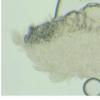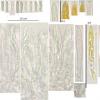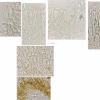
11-06-2025 16:26
Hi everyone, I am looking for the following protol

17-06-2025 12:10
Del pasado dia 4 en bosque de hayas, en tierraA

12-03-2025 17:54
Karl Soler KinnerbäckHi all!Do you agree with Scutellinia hyperborea? P

17-06-2025 12:02
Del pasado sabado, en bosque de hayas y avellanos,

13-06-2025 09:41
Hello.A cerebriform ascomycete sprouting scattered
• Possibly C. rubrotincta (from Zotto's folders): Spore size, long and tapering hairs.
Habitat: On dead, hollow, standing stems of herbaceous plant, 2-3 cm wide, lower part of stem but not base, damp when found, not seen on several other stems nearby, in a clearing, no bodies of water in the immediate vicinity, mixed deciduous woodland, mostly Betula pendula and Quercus robur, Low Weald, England (south), mid-April, after rain.
Associates: Lots of small brownish conidiophores, and a few larger black apothecia – possibly Pyrenopeziza (seems to be a common associate).
Apothecia: 20+ on the stem, in a loose group, generally scattered but occasionally 2-caespitose, 0.2-0.3 (0.5) mm diameter without hairs (< 0.6 mm with hairs), < 0.1 mm high (1.5 mm with hairs), pale yellowish with a hint of pink (apricot), shallow cupulate to discoid, translucent, gelatinous appearance and texture; margin distinct, more in-rolled until maturity, like receptacle; hairs whitish, more abundant and longer at the margin, when immature thick and white, when mature appearing conglutinated in regular groups, and pointing outwards; disk more translucent, greyish due to dark substrate, gelatinous appearance, eventually convex.
Storage and method: A short piece of stem stored overnight in a damp box, sections taken from a single large mature-looking apothecium, mounted in tap water (unfortunately median section was a little thick and turned hymenium down), a little pressure applied to separate cells of the hymenium, IKI added to water mount, KOH + CR added after IKI.
IKI: Apical rings weakly bb, some dextrinoid ascoplasm, hairs with yellow contents.
KOH + CR: Hairs strongly red, gel at apices dissolving, ornamentation remaining; exudate more greenish.
Asci: Cylindrical to mildly clavate, apex conical, IKI bb, croziers, 1-2-seriate, many discharging in water mount,.
• Living mature: ~ 33-45 x 4.5-5 (5.7) um, pars sporifera ~30-40%, apex more rounded-conical, spores diagonally oriented, one spore at apex, sometimes with hyaline to greenish VBs above base of ascus.
• Dead mature: ~30-38 x 3.5-4.5 um, pars sporifera ~60-90%, apex more acute-conical, small apical thickening ~1 um, spores more vertically oriented
• Discharged: Small poricidal opening, cylindrical, apex acute, usually with some amyloid material remaining at the extreme apex but once without, still relatively turgid, many small LBs.
Spores: Narrow-ellipsoid to fusiform, poles rounded to acute, usually heteropolar with the base more attenuated and acute (apex more rounded-obtuse), a few tiny shadowy LBs around the poles, OCI 1.
Vital spores measured in water mount: (6.9) 7.1-8.0 (8.7) × 1.7-2.1 µm, Q = (3.5) 3.6 - 4.2, n = 11, mean = 7.5 × 1.9 µm, Q mean = 3.9.
Paraphyses: Gradually lanceolate to filiform, 2.5-3 um wide, apex rounded-acute, ~3 septa, exceeding immature asci, very faint yellowish VBs (very lowly refractive and more noticeable at lower magnification), several shadowy LBs more noticeable in KOH + CR.
Marginal hairs: ~40-60 x 5-6 um, apices ~2.5-3 um wide, abundant at margin, some at flank, broad-cylindrical, tapering, sinuous, apex rounded, protruding part observed with 3-4 septa, 1-2 apical cells with very light ornamentation of tiny warts, ornamentation remaining in KOH, longer hairs with tangled apices, apparently conglutinated, bases apparently with VBs like paraphyses; some shorter hairs, 30-40 um long, clavate apical cell, apparently unornamented.
Exudate: Yellow-brown, thick, globular, gelatinous, on surface of ectal excipulum and short hairs around base.
Ectal ex: Very light yellowish at low magnification, hyaline at high magnification, surface with textura prismatica, internally possibly textura globosa.

Amitiés
Michel
This is my first Cistella sp., and some of the smaller spored species on dicots look quite similar. I didn't find any accessible key and I'm not sure about the substrate preferences, but I looked through Zotto's folder.
I did see the paper of Quijada et al. (2015) on Hyphodiscus and Cistella in the Canary Islands. Based on their suggestions (following Raitviir), the length of the spores and asci seem to fit better with C. hungarica, but I didn't see this species in Zotto's folder.






